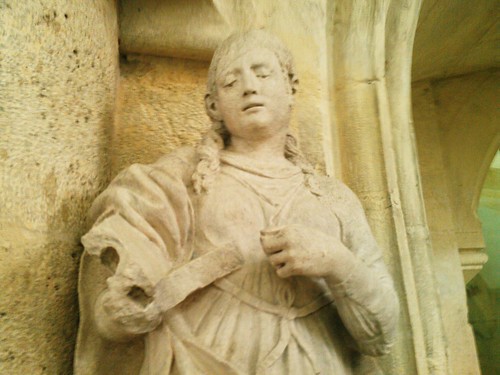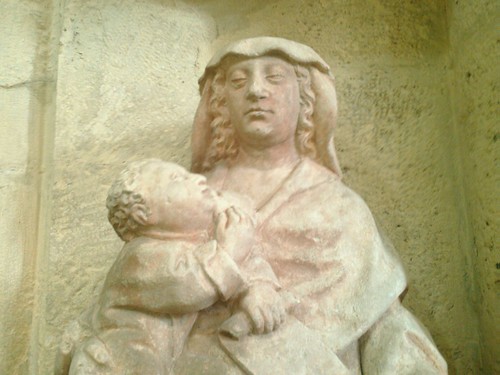The story of Abelard and Heloise is normally told as a great love story, a sort of medieval Romeo and Juliet. But there was much more to the story – Abelard was a rebel, and perhaps surprisingly a proponent of women’s ordination, at least in some forms.
This story is told in Gary Macy’s The Hidden History of Women’s Ordination: Female Clergy in the Medieval West. As that title suggests, Macy finds plenty of evidence that at least until the early 12th-century, the ordination of women was generally not particularly remarkable in the church, although ordination was — for both men and women — a less defined rite, something that formally placed an individual in a position, rather than an institutional rule and ladder.
It was Abelard’s much-hated teacher Anselm, the most celebrated scholar at the School of Laon, who was running a line that would completely remove women from ordained ministry, restricting true ordination to priests and deacons, and arguing that there were no true women deaconesses in the scripture, and only heretics had allowed them.
Macy says that Abelard was consistently and vehemently opposed to that position, writing for example in response to Heloise’s request for a history of the ordo of holy women, which, Macy suggests may have been “a cry for defense of women’s orders in the high Middle Ages”. In this work, Aberlard “argues that this ordo was established by Jesus himself and not by the apostles, specifically rejecting the teaching that only the male priesthood and diaconate were part of the original church. Further, this ordo predates even the Lord in the great Jewish women of Hebrew scripture, and in Anna and in Elizabeth, whom Abelard dramatically described as prophets to the prophets.”
Macy adds that both Heloise and Abelard asserted that the title abbess was the new name for the ancient order of deaconesses.
And, Macy adds, Abelard was far from alone in this in his time, but by the end of the 12th century, the memory of women’s ordination was being written out of church history. One of the early proponents of the “it never happened” school was Rufinus, writing between 1157 and 1159, who defined “real ordination” as ordination to the altar and everything else as mere commissioning to a job. Consequently, Macy concludes: “In one of the most successful propaganda efforts ever launched, a majority of Christians came to accept that ordination had always been limited to the priestgood and the diaconate and that women had never served in either ministry.”
In reaching this point, Macy has been able to recover just a few women from this great coverup, and a little about their circumstances. Hildeburga, the wife of Segenfrid, bishop of Le Mans from 963-996 is remembered because a later writer treated her husband disparagingly because he married and bequeathed a large portion of church property to his son. (But since churches were hereditary in the period, this was probably no big deal at the time.)
Namatius, the wife of a 5th-century bishop of Clermont-Ferrand, is recorded by Gregory of Tours, generally no friends of clergy wives, as pious and humble, and the donor of the church of St Stephen.
“She wanted it to be decorated with coloured frescoes. She used to hold in her lap a book from which she would read stories of events which happened long ago, and tell the workmen what she wanted painted on the walls.”
Then there’s the very curious Brigid of Ireland, who is ordained as a bishop in her own right, if by accident, since the ordaining bishop was “intoxicated with the grace of God”. And apparently to prove this right, while she was being ordained a pillar of fire ascended from her head.
Also surviving is the early medieval Mozarbic rite for ordaining abbesses (which was distinguished from the rite for abbots), Macy reports. “When an abbess is ordained, she is vested in the sacristy by one dedicated to God, and the religious mitre is placed on her head… At the conclusion of the rite, both received from the bishop a staff and a copy of the rule of the order, as well as the kiss of peace from the bishop”.
And the abbess had the duty to hear her nun’s confessions, with at least two of the rules stressing the importance of doing this daily. “For all intents and purposes, abbesses plated the same role for their communities in hearing confession and in absolving sin as did bishops or priests for their communities.” And it is clear that in some convents, communion services were not led by a priest, but most likely by the abbess.
This is all, in the modern context of controversy about the place of women in various churches — the subject of bishops currently consuming much energy in the Anglican communion — all explosive stuff, and the more powerful for the fact that Macy carefully positions himself outside the modern arguments, taking a place as merely a medieval scholar who stumbled across these facts and wanted to correct the historical record. Accompanying this is writing that seems almost deliberately dull – you can see the author tiptoeing over the modern political quicksands, sticking firmly to the “I’m only doing historical scholarship” path.
So there’s not gripping reading here, but important stuff. And there might even be a lesson in here for the modern church, which is, one analyst says women “feel forced out of the church because of its “silence” about sexual desire and activity, and because of its hostility to single-parent families and unmarried couples”.




 About
About